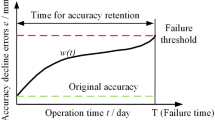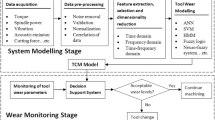Abstract
To enhance machining efficiency, tool change time has to be reduced. Thus, for an automatic tool changer attached to a machining center, the tool change time is to be reduced. Also the automatic tool changer is a main part of the machining center as a driving source. The static attributes of the automatic tool changer using the commercial code, ANSYS Workbench V12, were tried to interpret. And the optimum design of automatic tool changer arm was proposed by performing the multi-stage optimum design. The shape optimization of the automatic tool changer was proposed and the result was verified to obtain acceptable improvements. It is possible to obtain an optimized model in which the maximum deformation, maximum stress, and mass are reduced by 10.46%, 12.89% and 9.26%, respectively, compared with those of the initial model. Also, the results between conventional method by the design of experiments and proposed method by the multi-stage optimum design method were compared.
Similar content being viewed by others
References
LEE S W, LEE H K. Reliability evaluation of ATC for high-speed line center [J]. Journal of Korean Society for Precision Engineering, 2006, 23(6): 111–118. (in Korean)
BARK T Y. The design of automatic tool changer [M]. Korea Advanced Institute of Science Univ Press, 1977: 1–11. (in Korean)
ROY R, HINDUJA S, TETI R. Recent advances in engineering design optimization: Challenges and future trends [J]. CIRP Annals-Manufacturing Technology, 2008, 57: 697–715.
SONG J H, YANG B S, CHOI B G, KIM H J. Optimum design of short journal bearings by enhanced artificial life optimization algorithm [J]. Tribology International, 2005, 38(4): 403–412. (in Korean)
ALLAIRE G, JOUVE F, DE GOURNAY F, TOADER A. Combining topological and shape derivatives in structural optimization [C]// European Conference on Computational Mechanics. 2006: 644.
BAGCI E, AYKUT S. A study of Taguchi optimization method for identifying optimum surface roughness in CNC face milling of cobalt-based alloy [J]. The International Journal of Advanced Manufacturing Technology, 2006, 29(9): 940–947.
LAMBERTI L. An efficient simulated annealing algorithm for design optimization of truss structures [J]. International Journal of Computers and Structures, 2008, 86: 1936–1953.
SEKULSKI Z. Multi-objective topology and size optimization of high-speed vehicle-passenger catamaran structure by genetic algorithm [J]. Marine Structures, 2009, 22: 691–711.
SEO Y D, KIM H J, YOUN S K. Shape optimization and its extension to topological design based on isogeometric analysis [J]. International Journal of Solids and Structures, 2010, 47(11): 1618–1640. (in Korean)
JIA S, XIN W, XIACONG J, TAEKESHI I. Multi objective optimization based fast motion detector [J]. Lecture Notes in Computer Science, 2011, 6523: 492–502.
KIM J H, LEE M J, LEE C M. Geometric optimal design of an ATC arm using design of experiments [C]// Proceedings of the IASTED International Conference. 2010: 357–362. (in Korean)
LEE Y W, SUNG H G. Multi-phase optimization of quill type machine structures (1) [J]. Journal of Korean Society Precision Engineering, 2001, 18(11): 155–160. (in Korean)
LEE M J, LEE C M. A study on structural analysis and optimum shape design of tilting index table [J]. Journal of Korean Society Precision Engineering, 2009, 27(2): 86–93. (in Korean)
ARORA J S. Introduction to optimum design, [M]. McGraw-Hill, 2003: 8–9.
KIM H S, LEE Y S. Optimization design technique for reduction of sloshing by evolutionary methods [J]. Journal of Mechanical Science and Technology, 2008, 22(1): 25–33. (in Korean)
KIM J S. A study on the weight-saving design of the boom in high ladder vehicle [J]. Transactions of the Korean Society of Machine Tool Engineers, 2007, 16(2): 8–13. (in Korean)
Author information
Authors and Affiliations
Corresponding author
Additional information
Foundation item: Work(RTI04-01-03) supported by Grant from Regional Technology Innovation Program of the Ministry of Knowledge Economy (MKE), Korea
Rights and permissions
About this article
Cite this article
Kim, JH., Lee, CM. Multi-stage optimum design of magazine type automatic tool changer arm. J. Cent. South Univ. Technol. 19, 174–178 (2012). https://doi.org/10.1007/s11771-012-0988-3
Received:
Accepted:
Published:
Issue Date:
DOI: https://doi.org/10.1007/s11771-012-0988-3




